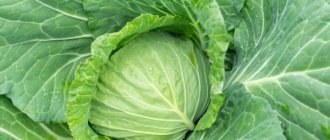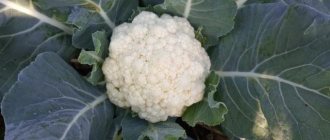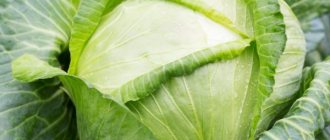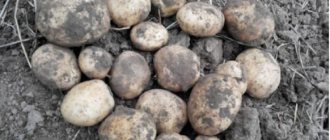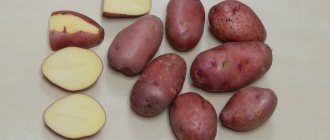Description
White cabbage variety Vyuga was bred in Siberia. It has long been included in the State Register of the Russian Federation. A universal-purpose vegetable, intended for cultivation in open ground in private plots and on an industrial scale.
White cabbage Vyuga is a late-ripening variety. From germination to technical maturity it takes from 140 to 160 days. The outer and inner stalks are short. The leaves of the vertical rosette are dark or gray-green, shaped like a lyre. The waxy coating is clearly visible. There are faint waves along the edges of the sheet.
The variety's heads are round, slightly flattened, and very dense (up to 4.6 points). When cut, the leaves are white-yellow, with virtually no voids. Fork weight from 1800 to 3300 grams. Some specimens reach 5 kg.
Attention! Vyuga cabbage, according to gardeners and consumers, is one of the best varieties for winter storage.
Popular mid-late cabbage varieties
Characteristics of popular mid-late cabbage varieties
| Name | Growing season | Description of the head of cabbage | Disease resistance | Shelf life |
| Favorite | 135-140 days | The heads of cabbage are dense, flat-round in shape, yellowish-green in color, white in cross section | Fusarium wilt | 6 months |
| Symphony | 130 days | Heads of cabbage are round, white, weighing up to 4 kg | Vascular bacteriosis | 4 months |
| Present | 120 days | The head of cabbage is medium, weighing 3-4 kg, round-flat in shape | Fusarium, blackleg | 5 months |
| Florin | 135 days | The head of cabbage is flat-round, weighing no more than 4 kg | Fomoz | 6 months |
| Dobrovodskaya | 125-130 days | The heads of cabbage grow round, weighing approximately 6 kg | Vascular bacteriosis, phomosis, blackleg | 6 months |
| Conquistador | 130 days | Heads of blue-green hue, large (5 kg) | Fusarium, necrosis and root diseases | 7 months |
| Busoni | 130 days | Heads of cabbage no more than 3 kg, dark green with a waxy coating | Fusarium | 7 months |
| Coronet | 130 days | Light green heads of cabbage, reaching 8 kg in weight | Necrosis, fusarium and damage to the root system | 7 months |
| Menzania | 130 days | The heads of cabbage are round, gray-green in color, on a high stalk, covered with a waxy coating | Necrosis | 7 months |
| Snowstorm | 130 days | Heads of cabbage are round in shape, white when cut, weighing up to 3 kg | Necrosis, fusarium and damage to the root system | 8 months |
Potatoes are a good harvest. How to grow potatoes from seeds. Potatoes under straw, in boxes, in bags, without hilling or weeding. How to grow potatoes in the garden
All the varieties described above grow well in open ground and do not require greenhouse planting. They store well and are resistant to diseases and cold. This list also includes Vyuga white cabbage. It is not very different from other late-ripening hybrids, but there are still differences.
Characteristic
Descriptions of the variety, photos and reviews of Vyuga cabbage will not be enough without characteristics. Let's look at the advantages:
- Taste properties. The variety has excellent taste; there is no bitterness in the cabbage leaves.
- Productivity is high.
- Use in cooking. Since the vegetable has a universal purpose, it can be used fresh and prepared as first and second courses. But it is best to use the Vyuga variety for fermentation, pickling and long-term storage. It can be stored for almost 8 months without loss of taste and quality characteristics.
- Agricultural technology. The length of the day does not negatively affect the development of cabbage. Can be grown on different soil compositions.
- Transportability. Heads of cabbage of the Vyuga variety do not crack either during cultivation or when transported over long distances, and do not lose their presentation.
- Diseases. The cabbage variety is resistant to many diseases, including vascular bacteriosis.
No disadvantages were noted by gardeners. The only thing you need to pay attention to is not to over-moisten the soil. Vyuga cabbage cannot tolerate this: the root system can rot, and mold appears on the lower leaves.
Tips and reviews from experienced gardeners
Summer residents share their experience in growing this variety:
Galina, Novosibirsk: “I’ve been growing blizzards for many years. It is suitable for sourdough and delicious in salads. We store the harvest in the cellar for a long time in winter. We do not shorten the stalk too much. I wrap each head of cabbage separately in newspaper and cover it with a blanket in severe frosts.”
Maria, Moscow: “Last year we grew this cabbage in the country for the first time. There were no problems, the heads of cabbage were cut somewhere in October, and they were stored on the balcony for a long time.”
Growing seedlings
White cabbage Vyuga, based on the characteristics of the variety, for the vegetable to fully ripen must be grown through seedlings in a risky farming zone. In the southern regions, sowing seeds in open ground is allowed.
Seedling method
In order for the plants to ripen at the required time, the seeds must be sown in the last ten days of March. According to the lunar calendar of 2021, it is recommended to complete the work in March: 20, 21, 26 or 30.
Soil and containers
A week before sowing cabbage seeds, the soil is prepared. You can use store-bought formulations, since all nutrients are fully balanced in them. If you prepare the soil yourself, you need to take equal parts turf soil, humus or compost, and river sand. Be sure to add wood ash under the cabbage.
Containers are chosen with a depth of at least 7-10 cm so that the root system does not feel oppressed during growth. Boxes or containers are doused with boiling water. You can add a few crystals of potassium permanganate. The containers are filled with soil and thoroughly poured with boiling water with potassium permanganate or boric acid.
Advice! The soil can be prepared differently: pour it into a sheet and steam it in the oven at 200 degrees for a quarter of an hour.
Seed preparation
Vyuga cabbage seeds germinate well. But they still need to be prepared:
- Selection. After pouring the seeds onto a flat surface, select large grains. Then they are poured into cold water. Specimens that have sunk to the bottom are suitable for planting.
- Disinfection. Seeds of the Vyuga variety in gauze are dipped in a light pink solution of potassium permanganate for half an hour, then washed in clean water.
- Hardening. The seeds are placed for a third of an hour in hot (no more than 50 degrees) salted water (1 tablespoon of salt per liter), then in cold water. After this, the gauze with the grains is placed on the bottom shelf of the refrigerator. This procedure allows you to grow healthy and strong Vyuga cabbage seedlings.
Sowing
The soil is sprayed with water at room temperature from a spray bottle, grooves 1 cm deep are cut and the seeds are laid out in increments of 3 cm. Glass is placed on top or film is stretched to speed up germination. As soon as the first sprout appears, the cover is removed. The temperature is reduced to 10 degrees so that the cabbage seedlings do not drag. Water as needed.
Picking
This procedure is optional. If the plants are comfortable in the container, then you can leave it in the box. To transplant seedlings of the Vyuga variety, on which 2 true leaves have formed, use separate cups or pots with a height of at least 10 cm. They are filled with soil identical to that used for growing the seedlings. It is advisable to pinch the tap root to enhance the growth of the root system.
Attention! When growing, cabbage seedlings are fed with wood ash and kept in a well-lit room at a temperature of 18 to 23 degrees.
Sowing without picking
For your own needs, you do not need a large number of cabbage seedlings. If the window sill area allows, you can sow the seeds in separate cups. The disadvantage of this method is the high consumption of seeds. After all, 2-3 seeds are sown in each glass, followed by the removal of weak shoots. But when transplanted into the ground, the plants are less injured; the Vyuga cabbage seedlings turn out strong, as in the photo.
Sowing seeds in the ground
In the southern regions of Russia, you can sow Vyuga cabbage seeds directly into open ground. To do this, prepare holes at intervals of 25 cm, with row spacing of 30 cm. Humus and wood ash are added to each hole and poured with boiling water and potassium permanganate.
Sow 2-3 seeds. Cover the top with a plastic bottle with a cork or film. If there is a threat of return frosts, then the bottles are not removed even after germination, only the cap is unscrewed for a day. After germination, weak plants are removed, leaving one seedling in each hole. With this method, no picking or transplanting to a new place is required.
Reviews of Vyuga cabbage
Gardeners willingly grow cabbage of the Vyuga variety. The reason is the yield and taste, as well as the keeping quality and versatility of the forks.
- Maxim Shulika : “Vyuga cabbage captivated me last year, when I first decided to try to grow it. Although there is not much experience in this matter, the harvest was not bad. Of course, my lady’s cabbage is far from the store-bought heads. Average weight is 3 kg, but it suits me quite well. Next year I will plant again.”
- Victor German : “A variety for those who love delicious sauerkraut. In my family, it is grown only for pickling - somehow it just happened that way. Every year I plant a row of this variety; it doesn’t go into storage - we salt the entire harvest. And in winter - when it gets a little dark - such sauerkraut makes the best salads!”
- Victoria Sergeeva : “I grow the Vyuga cabbage variety only by seedlings - it grows too slowly, maybe I don’t like the soil. But if you feed regularly (I do this once every 2-3 weeks), the harvest will be good. It lasts until January or February, just like when – the taste in winter is simply magical.”
Planting and care in the ground
From the description of the variety it follows that Vyuga cabbage is a light-loving plant, so when planning a vegetable garden, choose a sunny place for planting. The soil is prepared in the fall. Before digging, weeds are removed, compost and humus are added. Fresh manure is also not prohibited. During the fall and winter it manages to rot. In the spring, all that remains is to prepare the holes and fill them with wood ash.
Holes for Vyuga cabbage are made at a distance of 45-50 cm and filled with water. In each hole, depending on the condition of the soil, 1 or 2 liters. As a rule, white cabbage is planted in two rows with row spacing of up to 70 cm for ease of care. Each plant is buried down to the first true leaf. Work is carried out in cloudy weather or in the evening if the day is clear. In this case, the seedlings have time to adapt overnight and are less sick.
Advice! If the next day is very hot, cabbage plantings can be shaded with any available materials.
White cabbage
We cannot imagine our daily diet without white cabbage. It is included in many national dishes and is an excellent cure for all diseases.
Most of our gardeners grow cabbage
Many people plant several varieties at once for different purposes. At first glance, the varieties are no different from each other. But if you look closely, you can notice a slight difference.
The differences are manifested not only in the shape of the heads of cabbage: they are elongated, round, flat and flat-rounded. The taste and sugar content of cabbage also varies. Not only a professional, but also an ordinary experienced gardener can identify varieties.
White cabbage
Cabbage in central Russia, Siberia and the Urals is most often grown by seedlings. Seedlings require special rooms with a certain temperature, humidity and lighting. Hot, dry air in apartments is not suitable for these purposes.
Therefore, large farms use unheated greenhouses for seedlings. Now there are several hundred varieties of white cabbage alone. They are divided into varieties and hybrids.
Another, no less well-known division is based on ripening periods: early, middle and late. Each type and variety has its own advantages and disadvantages.
Early ripening
Early ripening white cabbage ripens 90-100 after germination. Typically, early-ripening varieties are distinguished by their small head size and increased looseness.
Such cabbage cannot be fermented; it is not suitable for storage. First and second courses, as well as fresh salads, are prepared from it.
Early cabbage
Early ripening varieties are planted in open ground with seedlings in late March-early April, depending on the region. With normal development, the first harvest can be harvested in mid-to-late June. Let's look at the most popular varieties and hybrids of early cabbage.
White cabbage is the most popular type, known since ancient times. Each head of cabbage contains a huge number of leaves, the shape of the fruit is round. Weight can reach 15 kg. Many trace elements, minerals and various vitamins make it one of the most valuable guests at any feast.
White cabbage comes in several types:
- Early (Pudovka, Kruidor, Discovery, Passat, Discover, Tsarskaya, Kazanskaya large-fruited, Ural Dawns).
- Middle early (Excalibur, Kabardinka, Titusa).
- Mid-season (Ochakovskaya yellow, Hollywood).
- Middle-late (Dobrovodskaya, Testament, Souvenir of the East, Gochi, Sigma).
- Late (Prostokvashino, Tropikanka, Traveler, Bolkhovchanka, Malakhovskaya, Ispolinskaya, Mara, Podgornaya, Okskaya).
Features of care
Caring for Vyuga is not difficult; agricultural techniques are almost the same for all varieties of cabbage. Although there are some nuances.
Watering
As already noted in the description, Vyuga is a moisture-loving plant. Watering should be regular, but there is no need to be zealous: excess moisture or drying out of the soil leads to disease or reduced yield. It is recommended to water the cabbage twice a week if the weather is dry. At least 10 liters of water will be required per square meter. During rainy periods, watering is reduced to a minimum.
Attention! At first, seedlings of the Vyuga variety are watered carefully so as not to expose the root system. As they grow, irrigation is carried out on the leaves.
Top dressing
In addition to watering, white cabbage of the Vyuga variety must be fertilized to obtain a decent harvest. Since gardeners try not to use chemicals on private plots, they can limit themselves to organic matter. According to reader reviews, infusions of mullein, chicken manure, and fermented green grass are excellent for feeding.
The amount and frequency of additional feeding of Vyuga cabbage depends on the characteristics of the soil and the condition of the seedlings, but no more than five times during the growing season. You need to understand that excess fertilizer causes the accumulation of nitrates.
Advice! It is advisable to combine fertilizing with watering.
Harvest and storage
The peculiarity of the Vyuga variety is that its heads of cabbage can be stored for up to 8 months. This is longer than other varieties. And they are more resistant to diseases that occur under improper storage conditions. The crop ripens 130–140 days after emergence. Cabbage harvesting takes place in dry weather. Don't wait for frost. The minimum permissible temperature on the day of harvest is +5…+7°С. Cut the stalk with a sharp knife, leaving a height of 8–12 cm.
Place for storage in boxes or boxes with good ventilation. The air temperature in the room should be from 0°C to +5°C, humidity - 90–95%. The Vyuga variety deserves attention for its taste and commercial qualities. Long shelf life, good shelf life, disease resistance and unpretentiousness are additional arguments for growing this particular variety on the site.
Diseases and pests
The white cabbage variety Vyuga is resistant to many diseases. But powdery mildew and blackleg can bother her. If diseased plants appear, they must be immediately removed and destroyed. And the place where the bushes grew should be disinfected. Preventive measures are a mandatory procedure. It is carried out at the stage of preparing seeds and soil, and then before transplanting. Potassium permanganate and Bordeaux mixture are used as remedies.
Among the main pests are:
- butterflies and caterpillars;
- cruciferous flea beetles;
- cabbage fly;
- aphids and slugs.
It is not necessary to use pesticides as a means of pest control. By planting marigolds, marigolds, nasturtiums, parsley, dill, celery or other strong-smelling garden plants between the plants, you can repel most insects. You can use mulching to combat slug infestations.
If nothing works, it is recommended to use special drugs:
- Nemabact;
- Aktofit;
- Bicol.
These products also destroy fungi and nematodes.
Other varieties of white cabbage:
Review: Seeds Search white cabbage “Vyuga” - Cabbage, as you know, is very healthy.
Greetings to all friends and readers of my review.
I continue the series of reviews “seeds and the final result”. In this review I will talk about white cabbage “Vyuga” from the selection and seed production company POISK. This cabbage is late-ripening (as everyone already knows, you need to plant early cabbage (for summer-autumn consumption) and mid-late cabbage for pickling cabbage and for storage. It is not recommended to salt early cabbage (it will be soft and not very tasty). This variety of cabbage is ideal for pickling.
Seeds for seedlings should be sown in the first half of April. But since I sow seeds in a greenhouse, my timing is slightly delayed, because the greenhouse is prepared for planting in the second half of April. The seeds sprouted very well - now the seedlings are ready for planting in the ground. Until the seeds sprout, do not forget to water the ground.
We plant seedlings in open ground in the second half of May. We dig up the seedlings with a clod of earth to minimize trauma to the roots.
We make a furrow with a hoe, pour water on it and lay it out, choosing beautiful and strong seedlings, at a distance of 50 centimeters (if there is not enough land, you can at a distance of 40 centimeters). There are 70 centimeters between the rows (again, if there is not enough land, but you want to plant a lot of things, you can do 60 centimeters). We plant seedlings in the evening or in cloudy weather.
We dig in, water and wait. The next day, the seedlings may look a little wilted - they have suffered stress, but by the evening they will all rise. My seedlings have taken root all well.
And so she began to grow, beautiful new leaves began to grow.
And then the heads of cabbage began to form. Cabbage loves water - while it is growing and the heads of cabbage are starting to form, it needs to be watered twice a week. The lower leaves turn yellow and fall off when there is a lack of moisture (cabbage takes the missing moisture from the lower leaves, that is, in fact, it will not be lost - it takes care of itself if the owner and mistress have no time to water it). You can sprinkle the cabbage with ash. To prevent caterpillars from eating your cabbage, place halves of white eggshells on the leaves, or better yet, stick in sticks and hang the shells on them. If caterpillars do appear, they must be collected manually. This year I didn’t have caterpillars, but last year my husband collected them, since I don’t really like handling caterpillars. I don’t recommend using pesticides, because we plant a garden for ourselves in order to eat environmentally friendly products, and we can buy food stuffed with poisons and chemical fertilizers in the store. I have nothing but manure, ash and urea at my dacha. Urea – against pests (in spring and autumn), for trees (granules) and for garlic (solution).
And we begin to harvest at the end of September - October. We do not cut off the stalk to the very base, leaving a little. This variety is intended for long-term storage. We leave only whole cabbage with a good stalk for storage. This is how I store it: I wrap the cabbage in newspaper and stack it on the balcony. When it’s slightly frosty, I cover it with a blanket. Well, when it’s really cold I take it out into the stairwell, it’s still cooler there. Well, when the cellar appears, then storage will not present any difficulties.
The size of the cabbage is not bad, the heads are beautiful, the cabbage is dense.
Shred the cabbage for pickling. The cabbage is juicy and releases its juice perfectly.
And it turned out to be very tasty crispy sauerkraut. For those who like sauerkraut not to be soft, I want to share how I make it. Chop into a bowl, add carrots and salt. And then I stir it gently. Then I put it in parts into the pan and then press it down firmly with my fist. The next day or every other day I pierce it. After two or three days I put it in jars.
So I did a brief review, I hope it will be useful to someone in order to grow excellent cabbage next season, which will delight you and give you strength to grow vegetables in your garden.
I recommend this variety for consideration for planting next year.
I wish everyone optimism, good luck and a good harvest.
Varieties for pickling
Cabbage that ripens early does not have time to collect enough sugars and vitamins. Therefore, it is not suitable for pickling and pickling. Some late-ripening varieties, for example, “Amager” and “Kolobok,” are also not suitable for this. They contain a glycoside substance that imparts bitterness.
The sweetest and juiciest sauerkraut comes from mid-season cabbage. Particularly good are “Slava 1305”, “Belorusskaya 455”, “Moskovskaya Pozdnyaya”, “Kharkovskaya Zimnyaya”, “Vyuga”.
Snowstorm
This vegetable was bred in Siberia. Belongs to mid-late varieties. Many farmers consider it one of the best for winter storage. "Vyuga" is resistant to unstable weather conditions and temperature changes. But she has one peculiarity. You can’t moisten the soil too much; it really doesn’t like it. In another case, the roots begin to rot and mold appears on the lower leaves.
Powdery mildew, butterflies, caterpillars, cabbage fly, black leg are the main pests of this variety. Preventive measures are definitely needed.
Moskovskaya late 15
This is a late ripening variety. It grows well in lowlands. Loves fertile soil and good watering. It has a high stump and large heads of cabbage, so it can fall over on its side. To do this, the cabbage is hilled high.
Its disadvantage is the tendency of the heads to burst when there is an excess of watering. The main advantage is the high yield, which ranges from 602-885 c/ha. The maximum reached 1015 c/ha. This type of cabbage does not require care. It ferments very quickly, which is why it is used.
Kharkov winter
This is late cabbage. Most farmers advise watering this variety daily after planting the seedlings. This variety can be grown without problems by sowing seeds. In this case, the heads reach large sizes, due to which the roots are fixed very deeply in the ground and the crop becomes viable.
The advantage of this cabbage is that it can withstand hot weather well. Tolerates temperatures down to -2°C well. Cabbage is resistant to diseases such as spot necrosis and bacteriosis. This variety is versatile in nutrition.
How and when to plant
Site preparation must begin in the fall. To do this, you just need to dig up the bed with the bayonet of a shovel. Then add manure, humus and ash. Planting this cabbage can be done by seeds or seedlings.
Rassadny
Seeds must be sown at the end of March. To do this, prepare wooden boxes, fill them with earth mixed with ash and humus. Now make grooves and place the seeds to a depth of 1 cm. A distance of 3 cm should be maintained between them. In addition, before planting, the grains should be kept in hot salted water for 30 minutes, and then in cold water for several minutes. This will allow you to get strong shoots.
After planting, moisten the soil and cover the box with film. The covering material can be removed after the first shoots have formed. As soon as they form 2 true leaves, you can pick them. Separate cups are used for this. Already in mid-May, you can plant ready-made seedlings in the ground.
To do this, you need to choose a well-lit place so that there is no shadow there, because Blizzard is a light-loving vegetable. There should be a distance of 70-100 cm between the rows. The planting depth is up to the bottom leaf.
This video will help you understand how the Transfer cabbage variety is grown.
